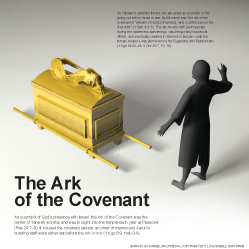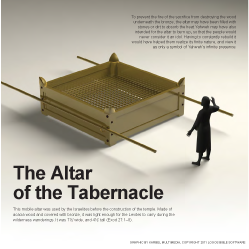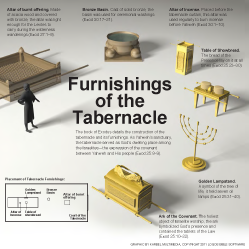3:1–51 Chapter 3 opens by identifying Aaron’s four sons who were ordained as priests (Lev 8–10). Most of the chapter addresses the responsibilities of the Levites, especially as related to taking care of the tabernacle. Numbers 3:14–39 describes a special listing of all Levite males, one-month old and upward, by fathers’ houses and by clan. Each clan of Levites has a particular responsibility and is positioned in a specific location with respect to the tabernacle. The Levites are dedicated to the service of Yahweh in place of all the firstborn of Israel, who were set aside for Yahweh because of the Passover event (vv. 11–13, 40–51; Exod 13:1–2; see Exod 11–12; 22:29–30; 34:19–20). |
3:1 Aaron and Moses A more complete genealogy of Moses and Aaron, who are brothers from the tribe of Levi, is found in Exod 6:14–27; the present verses only mention offspring. Moses’ son, Gershom (Exod 2:22), is not mentioned in either passage, leaving Aaron’s sons to take center stage.
Yahweh spoke to Moses Refers to either the burning bush episode (Exod 3–4) or the times when Yahweh gave Israel the law through Moses (Exod 19–Lev 27). Geographically, “Mount Sinai” here means the mountain itself (compare Exod 3:1–3; 24:9–11), as opposed to the wilderness of Sinai (Num 3:14; compare 1:1).
itself (compare Exod 3:1–3; 24:9–11), as opposed to the wilderness of Sinai (Num 3:14; compare 1:1).
3:2 the descendants of Aaron The office of priesthood was determined by biological descent from the line of Aaron. Aaron was the first high priest; his eldest son inherited the office of high priest, and his eldest son, and so on.
Nadab the firstborn, Abihu Nadab would have been the high priest upon Aaron’s death, but he himself, along with Abihu, died due to reckless behavior before Yahweh (Lev 10:1–3).
Eleazar The deaths of Nadab and Abihu leave Eleazar as Aaron’s eldest living son; therefore, Eleazar inherits the office of high priest upon Aaron’s death (Num 20:22–29).
Ithamar The youngest of Aaron’s four sons who led the Levites in carrying out the responsibilities of the tabernacle (4:28, 33; Exod 38:21).
3:3 priests, the anointed ones whom he consecrated as priests The method of anointing and ordaining the priests is prescribed in Exod 29 and carried out in Lev 8.
3:4 a strange fire See note on Lev 10:1. The Hebrew phrase used here, esh zarah, (“strange fire”) could refer to fire that was not derived from the large bronze altar in the courtyard as commanded (Lev 16:12; Num 17:11). In response to the death of Nadab and Abihu, the text of Lev 10:9 prohibits priests from drinking while on-duty, which suggests that the brothers may have been intoxicated when they made the error.
they had no children. Eleazar and Ithamar served as priest Although all of Aaron’s four sons were anointed and ordained as priests, this statement could mean that only two served at a time.
3:5–39 This passage describes the duties of the Levites, beginning with an overview (Num 3:5–10), followed by the explanation that the Levites’ service is designed to replace the dedication of the firstborn (vv. 11–13; compare vv. 40–51), and continuing with assignments specific to each clan and household (vv. 14–39). |
3:7 They shall observe his duties and the duties of the entire community One of the Levites’ main responsibilities was guarding the priests against defilement from those outside the tabernacle grounds. They also protected the whole congregation by guarding the tabernacle against ritual impurity since violating sacred space could incur the wrath of God (1:53). This way of life began early, perhaps even from infancy (v. 15), and continued into old age (8:25–26).
main responsibilities was guarding the priests against defilement from those outside the tabernacle grounds. They also protected the whole congregation by guarding the tabernacle against ritual impurity since violating sacred space could incur the wrath of God (1:53). This way of life began early, perhaps even from infancy (v. 15), and continued into old age (8:25–26).
before the tent of assembly The priests were exclusively responsible for guarding the tent structure that housed the holy place and the most holy place (18:5). Non-priestly Levites were not allowed to enter this part of the tabernacle (18:3).
3:8 the vessels of the tent of assembly Such as the ark of the covenant and the table of the bread of the Presence;
and the table of the bread of the Presence; see Exod 25–27.
see Exod 25–27.
3:9 You will give the Levites to Aaron and to his descendants See Num 3:11–13. The Levites fulfilled the requirement that the firstborn be given back to God (vv. 11–13, 40–51). The Hebrew term for “give” (nathan) also means “dedicate” or “establish” (8:16–18; compare v. 41); the Israelites essentially “donated” or “offered” the Levites back to God.
surely assigned to him from among the Israelites This is explained in more detail in Num 3:11–13, 40–51; and 1:47–54.
3:10 stranger who approaches All four occurrences of this phrase in the ot appear in the book of Numbers. The first two instances describe unauthorized entry into the sanctuary courtyard (1:51; 3:10). The latter two concern entry into the tent structure itself (vv. 38; 18:7). God authorized the priests to kill anyone who entered sacred space without authorization.
3:12 in the place of all the firstborn of The substitution of the Levites in place of the firstborn for the service of the tabernacle explains what it meant that the firstborn be dedicated to God (compare Exod 13:1–2; note on Num 3:1–51).
3:14 the desert of Sinai The book of Numbers begins in the wilderness of Sinai (Num 1:1; 3:14), whereas the books of Exodus and Leviticus take place mostly on Mount Sinai.
3:15 from one month The age at which the firstborn became eligible for redemption (see vv. 40–51; compare note on vv. 1–51).
3:17–20 This genealogy |
3:21–39 The eight clans of Levi—the Libnites and Shimeites descended from Gershon, the Amramites, Izharites, Hebronites, and Uzzielites descended from Kohath, and the Mahlites and Mushites descended from Merari—now receive instructions regarding where they will camp when the Israelites are at rest, and what their precise duties will be. These duties are discussed in more detail in Num 4. |
3:24 the leader of The Hebrew term used here, nasi, refers to a leader of a clan. The word is sometimes translated as “chief” or “prince.”
3:25 the responsibility of The Hebrew term used here, mishmereth, refers to trusted service. The duties of the Levites are not just about keeping the tabernacle under guard, but reflect the trust Yahweh has in the tribe of Levi.
the curtain of the doorway of The cloth hanging designated as the doorway into the holy place of the tabernacle. Its construction is prescribed in Exod 26:36–37.
3:26 the hangings of the courtyard That is, the curtains that blocked off the tabernacle courtyard from the rest of the camp. This wall of curtains had its own screen similar to the one at the entrance of the tent itself. These are prescribed in detail in Exod 27:9–18 and constructed in Exod 38:9–18. The Gershonites are entrusted with the outer coverings of the tabernacle courtyard and the material coverings of the tent shrine itself.
the altar The bronze sacrificial altar in the courtyard of the tabernacle (see Exod 27:1–8). The duty of the Gershonites pertains to the screens around the altar. The actual altar was assigned to the clans of the Kohathites (Num 3:31).
in the courtyard of the tabernacle (see Exod 27:1–8). The duty of the Gershonites pertains to the screens around the altar. The actual altar was assigned to the clans of the Kohathites (Num 3:31).
3:31 Their responsibility The Kohathites were responsible for all the furniture of the tabernacle including the ark of the covenant, the table, the altars, the lampstand, and other various utensils.
ark Refers to the ark of the covenant; see Exod 25:10 and note.
see Exod 25:10 and note.
the table The table for the bread of the presence, drink offering, and incense in the holy place (Exod 25:23–30).
drink offering, and incense in the holy place (Exod 25:23–30).
lampstand The golden lampstand with seven lamps in the holy place (Exod 25:31–40).
with seven lamps in the holy place (Exod 25:31–40).
the altar Refers to the altar of incense, the small altar stationed in front of the veil leading to the most holy place, where the ark of the covenant was kept (see Exod 30:1 and note); and the great sacrificial altar in the courtyard of the tabernacle (see Exod 27:1–8).
the small altar stationed in front of the veil leading to the most holy place, where the ark of the covenant was kept (see Exod 30:1 and note); and the great sacrificial altar in the courtyard of the tabernacle (see Exod 27:1–8).
the vessels of Refers to the various gold utensils described in Exod 37:16.
the sanctuary Refers to inside the tented structure within the tabernacle courtyard, in this case, the holy place.
3:32 Eleazar son of Aaron Aaron’s eldest surviving son had oversight over the Levites. Eleazar would later succeed Aaron as the high priest (Num 20:22–29).
3:36 the frames of the tabernacle The clan of Merari was responsible for all the structural elements of the tabernacle. The construction of the frames of the tabernacle and their component parts, most of which are listed here, are detailed in Exod 26:1–37; 35:30–36:38.
3:37 around the courtyard A system of pillars, bases, pegs, and cords was also used for the outermost curtain of the tabernacle, which separated the courtyard from the camp. This is detailed in Exod 27:9–19; 38:9–20.
3:38 Moses and Aaron and his sons Meaning Aaron’s descendants, since Moses’ son Gershom is not mentioned in the genealogies of Exod 6:12–27 or Numbers.
before the tabernacle to the east Refers to where the priests camped and stood on guard duty. Because it contained the entrance to the sacred space, the eastern side of the tabernacle was the most vulnerable and the most important. The other three sides were assigned to the Levites.
Whenever the tabernacle was assembled, its opening faced east. For some cultures in the ancient Near East, the orientation of the deity’s dwelling was crucial for its efficacy. With the opening of the tent or temple facing eastward, the deity witnessed the rising of the sun and the emergence of a new day for His or Her people. In the case of Israel, they must move east if they are going to enter the promise land; therefore, the tabernacle always faces the direction in which they are headed.
for the Israelites The guard was instituted to protect people from God’s wrath, which often took the form of a death sentence, for violating sacred space (Num 1:53).
3:39 twenty-two thousand This number becomes important upon the counting of the firstborn. See v. 43.
3:40–51 The Levites are set apart for Yahweh in place of the firstborn, who are counted in this passage (compare vv. 11–13; note on vv. 1–51). The consecration of the firstborn was commanded previously, in Exod 13:1–2; 22:29–30; 34:19–20. |
3:40 firstborn male Now that the Levites have been counted, the firstborn males of all the other Israelite tribes must be counted and redeemed.
3:41 you will receive the Levites for me The Levites are offered to God for the service of the tabernacle, in place of all the firstborn Israelites. See note on Num 3:9.
3:43 twenty-two thousand two hundred and seventy-three The Levites number 22,000 (v. 39) and are therefore 273 people shy of an even exchange. Therefore, the discrepancy must be covered by the redemption specified in vv. 46–48.
3:45 in the place of all the firstborn See note on v. 12.
3:46 the ransom of The Hebrew word used here, peduyim, signifies the economic value placed on the service of the person who is either buying their right to freedom or having their right to freedom purchased on their behalf.
3:47 five shekels a person A shekel is a unit for weighing metal as currency. One silver shekel weighed approximately 11–13 grams.
five shekels a person This counting and price is about the redemption of these 273 individual, firstborn lives (compare note on vv. 1–51). The Hebrew idiom used for taking a head count is literally “per skull” (gulgoleth in Hebrew; compare 1:2; Exod 38:26). The more common word for “head” is rosh which can be used figuratively to refer to the male head of the household; here the text makes a distinction.
in the sanctuary shekel In addition to their religious function, ancient temples and shrines served as the centerpiece of economic, political, and social activities, including the regulation of currency, storing taxes, and record keeping.
gerahs The Hebrew term used here, gerah, is likely cognate to the Mesopotamian giru (1/24 of a shekel in Mesopotamia’s monetary system). Coins found in Israel and marked gerah weigh just over half a gram, on average (compare Exod 30:13).
is likely cognate to the Mesopotamian giru (1/24 of a shekel in Mesopotamia’s monetary system). Coins found in Israel and marked gerah weigh just over half a gram, on average (compare Exod 30:13).

|
About Faithlife Study BibleFaithlife Study Bible (FSB) is your guide to the ancient world of the Old and New Testaments, with study notes and articles that draw from a wide range of academic research. FSB helps you learn how to think about interpretation methods and issues so that you can gain a deeper understanding of the text. |
| Copyright |
Copyright 2012 Logos Bible Software. |
| Support Info | fsb |
 Loading…
Loading…





